12
ZERO POINT ENERGY CAN POWER THE FUTURE
Thomas Valone, Ph.D., P.E.
NOTE: This essay is an excerpt from the book Zero Point Energy: The Fuel of the Future by Thomas Valone, Ph.D., P.E.
INTRODUCTION
Up until now the use of zero point energy (ZPE)*10 for electricity generation was mere fantasy and science fiction. No one thought it possible for ZPE to offer a source of unlimited energy for homes, cars, and space travel. Some “experts” still say zero point energy can do nothing useful. The experimental evidence, however, now incontrovertibly shows that ZPE is present in measurable quantities in coils and semiconductors. Furthermore, ZPE can be turned on and off and produce an attractive or repulsive force in one direction, besides moving electrons to create electricity flow in a circuit and rectified in semiconductor diodes. All of these discoveries have been made and published only in the past few years, which indicates that the future energy trend is toward ZPE power.

Figure 12.1. Spiral design for a vacuum fluctuation battery
Zero point energy is the sea of energy that pervades all of space and every atom, often called the physical vacuum. Furthermore, it is estimated to exceed nuclear energy densities. But what is it really? It is the nonthermal, “kinetic energy retained by the molecules of a substance at a temperature of absolute zero.”1 Still, most people maintain their doubt as to whether it can be found to be useful for human energy needs. This includes the U.S. Department of Energy “Ask a Scientist” official website. A fifteen-year-old submitted a question, “Would Zero-Point Energy be a better source of power than Antimatter?” The answers include phrases like “a lousy source of energy,” “no idea how to do this,” “I can’t imagine how it could be practical,” and “no way to extract the zero point energy from a molecule in order to use it.”2
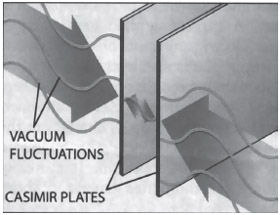
Figure 12.2. Casimir cavity
Looking for a source of ZPE, quantum mechanics tells us, “It is possible to get a fair estimate of the zero point energy using the uncertainty principle alone.” The intimate connection of the average value of ZPE (= ½ hf, where h is Planck’s constant) to the uncertainty principle is an intellectually satisfying discovery in the Appendix of the book Zero Point Energy: The Fuel of the Future, by this author.3
Regarding energy extraction from ZPE, the first barrier to resolve is the hotly contested question of whether the zero point field (ZPF) is conservative. (Unlike politics, conservative fields in physics are those that conserve energy, thus obeying the first law of thermodynamics.) If ZPE is not conservative, then we can extract “an infinite amount of energy” from the vacuum, according to the late Dr. Robert Forward. However, if it is proven that the ZPF is a conservative field, we can still extract energy from it. It is just that we would have to put energy in and store it somehow to get it out again, like Forward’s invention (figure 12.1). “It does reflect work done by the ZPF on matter.”4
The evidence so far is in favor of a nonconservative ZPF, with arguments still raging on both sides. In addition, the capability of ZPF storage and retrieval has convincingly been presented by Forward with his ZPE corkscrew charge device he called a vacuum fluctuation battery.5 An article titled “Energy Unlimited” was published a few years ago when Professor Jordan Maclay from the University of Illinois received a NASA grant to try to extract ZPE from elongated, oscillating, tiny metal boxes.6 A physics journal article points out, “Vacuum fluctuations remain a matter of debate, mainly because their energy is infinite. More strikingly, their energy per unit volume is infinite.”7 Interestingly, this fact has created intellectual difficulties among physicists that have only been artificially eliminated: “Problems with the infinite energy of vacuum fluctuations has led to the view that vacuum energy may be forced to vanish by definition . . . [from] the need to regularize the infinite energy-momentum tensor.” However, this quick fix causes even more complications. “This procedure gives rise to ambiguities and anomalies, which lead to a breakdown at the quantum level of usual symmetry properties of the energy-momentum tensor.”8
WHY ATOMS DON’T COLLAPSE
To understand how fundamentally real ZPE is for sustaining our reality, it is worthwhile noting that ZPE is fundamentally responsible for atomic stability, much like an “atomic Casimir effect,” according to Margaret Hawton.9 When I spoke with Dr. Harold Puthoff, from the Institute for Advanced Studies in Austin, Texas, he described his plans, along with Dr. Eric Davis, for measuring the electron levels of a hydrogen atom while it is in a Casimir cavity (figure 12.2). Puthoff proposed years ago that ZPE determines the ground state of hydrogen in the journal Physical Review. Recently, he arranged access to the facilities for testing his theory in a Casimir cavity that restricts the range of frequencies of ZPE around the hydrogen atoms.10 According to Puthoff, this should show depressed or lowered electron levels as a result of less vacuum fluctuation activity of virtual particles that normally supports each electron level, in the same way that restricted virtual particle density inside a Casimir cavity causes the Casimir force to push inward.
A classic New Scientist journal article, with the same article title as this section, describes this phenomenon in more glorious detail. Zero point energy stabilizes the electron in a set ground-state orbit. It seems that the very stability of matter itself appears to depend on an underlying sea of electromagnetic zero point energy.11
LIMITATIONS ON ZERO POINT ENERGY
While the facts support an unlimited energy plenum for the quantum vacuum, the arguments still support conservative, “right-wing physics.” The actual estimates of energy density of even the limited ZPF (bounded by a maximum frequency) however are very impressive. For example, if we presume that the minimum possible wavelength is limited to the size of the proton, Nobel Prize–winning physicist Dr. Richard Feynman calculated that the energy density of the ZPF would be ten raised to the 108th power joules per cubic centimeter (10108 J/cc)!
Today, physicists want to look at even smaller vibration units like subatomic particles and so on. This makes the ZPF energy density escalate even more. In comparison, if we convert energy to mass using E = mc2, we find that the equivalent “mass density” of the ZPF is ten to the ninety-fourth power grams per cubic centimeter (1094 g/cc). Compare that with typical nuclear densities of ten to the fourteenth power grams per cubic centimeter (1014 g/cc).12 Therefore, gram for gram, ZPE offers almost ten to the eightieth times more energy for the same amount of space as nuclear reactors. Assuming they have the same efficiency, one ZPE engine equals 1080 nukes. It can be concluded that empty space contains more energy than matter does, for the same volume, even if we convert all of the matter into energy.
In a Los Alamos Laboratory, the Casimir force from ZPE was measured (in 1997) for the first time with conductive plates and found to be within 5 percent agreement with theory.13 At AT&T Bell Labs, Federico Capasso designed a special semiconductor device that will only allow electrons to resonantly tunnel to the other side of a semiconductor layer because of the presence of zero point energy.14 Zero point energy has been offered as a power source for the advanced energy and propulsion systems the government supposedly has in classified programs, to “produce vast amounts of energy without any pollution.”15
New Scientist reported on NASA’s Breakthrough Propulsion Physics First Project award to Illinois Professor Jordan Maclay “to study the energy of a vacuum.”16 In Europe, the University of Leicester, in the Virtual Microscopy Centre and the Nanoscale Interfaces Centre, has put the university in a key position to take a lead in Casimir force measurements in novel geometries. It led to the 2005 award of an €800,000 grant (NANOCASE) from the European framework 6 NEST (New and Emerging Science and Technology) program to lead a consortium from three countries (United Kingdom, France, and Sweden). The program will use the ultra-high-vacuum atomic force microscope installed in the Physics and Astronomy Department under Dr. Chris Binns to make very-high-precision Casimir force measurements in nonsimple cavities and assess the utility of the force in providing a method for contactless transmission in nanomachines.17 The NANOCASE grant is the largest ZPE grant issued in the world so far.
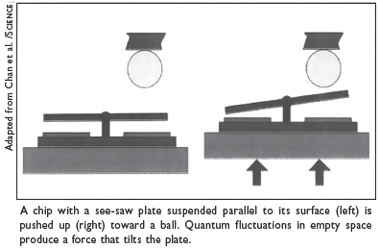
Figure 12.3. Nanoscale seesaw powered by ZPE. Source: Science magazine.
THE CONVERSION OF ZPE
Now to explore the theme of this article, it is argued that the practical methods for converting ZPE to electricity are finally emerging. Localized or distributed electrical energy generation, as a result, looks much more promising than ever before. In 2001, Popular Mechanics featured an article talking about putting “free energy to work” while moving a nanoscale seesaw (figure 12.3), which activates the Casimir force at distances less than one micron (1,000 nm).18 In 1998, a physicist formerly with the Jet Propulsion Laboratory, Fabrizio Pinto (who also worked with Robert Forward), invented and patented a nanoscale ZPE engine that obeys the laws of thermodynamics and pumps electrons, with the help of a tiny microlaser, just like an electrical generator. The effect of the microlaser pulses, which momentarily radically alters the Casimir force in the engine cavity, far exceeds the power input.
In the event of no other alternative explanations, one should conclude that major technological advances in the area of endless, byproduct-free, free-energy production could be achieved.19
Pinto’s accomplishment has brought much-needed legitimacy to the ZPE conversion arena by proving thermodynamically that electricity generation is the outcome.
While presenting his keynote address at the 2006 Second International Conference on Future Energy in Washington D.C.,20 Pinto surprised the audience with details proving that the vacuum has “pressure, density, and substance.” He also emphasized the fact that the vacuum can move physical objects, such as with the Casimir force. Pinto provoked the issue by asking, “Is empty space really worth nothing?”21
When a gamma ray decays to a positron and an electron in Wilson cloud chamber experiments, the tracks left by the particle and antiparticle are clearly seen as they move away from each other with oppositely spinning paths.22 Yet, the great quantum physicist Paul Dirac explains that in those days, people were very reluctant to postulate the existence of a new particle, even though they had seen it in the lab.
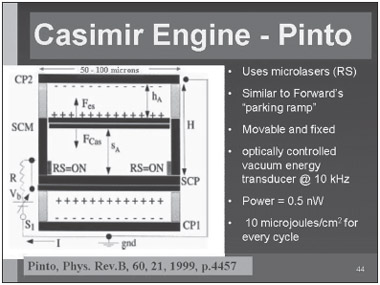
Figure 12.4. Casimir engine
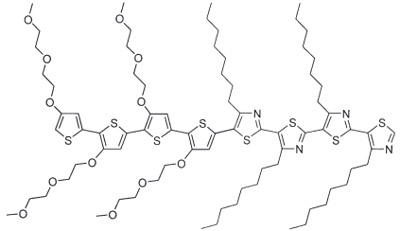
Figure 12.5. Electrically rectifying diodes come in nano-size (thin film) and pico-size (molecular).
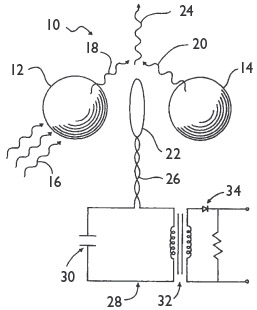
Figure 12.6. Drawing from Air Force ZPE Patent 5,590,031 by Dr. Frank Mead
When asked, “Why had experimenters never observed these antiparticles in cloud chambers?” Dirac’s response was that a bias existed against new particles. This is very much like the present situation with ZPE. Physicists acknowledge the theory, publish papers on the subject, with an exponentially increasing number of papers devoted to the Casimir effect,23 and still do not solve the energy crisis. However, the U.S. Air Force patented a simple method for resonantly amplifying certain ZPE frequencies. Dr. Frank Mead proposed resonant dielectric spheres that create lowered beat frequencies that may be able to be rectified and perhaps charge a battery (figure 12.6).
ZPE research shows today that vacuum fluctuations are present even in semiconductors, coils, and diodes. This is a new direction for development that has been discovered, which offers hope for a solid-state ZPE generator in every home, car, plane, and spaceship. The future will be much more stable, even with environmental disasters, since the electricity will not fail along with any other calamity. The practical devices that have a demonstrated ability for converting the ZPE non-thermal noise into useful electrical generation use semiconductors, coils, or diodes, with diodes being the most convenient.
SOLID-STATE DIODES
In 1994, J. Smoliner reported, for the first time, resonant tunneling while applying no voltage at all to the one-dimensional quantum wells that his team had created. They used “anharmonic oscillation” to substitute for zero point energy, which they ignored “for simplicity,” though it was powering the tunneling of their electrons in each well. Figure 12.7 shows the remarkable achievement, where the electrons prefer a zero voltage bias for the best results.24
The argument that Zero Point Energy: The Fuel of the Future makes is that there exists a class of diodes (rectifiers) that operate at “zero bias” (no voltage applied to make them work) and up into microwave frequencies that are suitable for generating trickle currents from the zero point energy quantum vacuum because of natural nonthermal electrical fluctuations (Johnson noise).
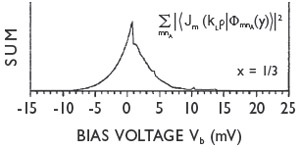
Figure 12.7. Chart from a German research project showing an electron tunneling through a barrier at zero bias voltage
Furthermore, there are peer-reviewed journal articles that also show tunneling at zero voltage (zero bias). Several microwave diodes in the book excerpt also exhibit this feature. However, you have to appreciate that the noise level (1/f noise or Johnson noise) is where ZPE manifests. (See Practical Conversion of Zero-Point Energy: Feasibility Study of the Extraction of Zero-Point Energy from the Quantum Vacuum for the Performance of Useful Work for a more rigorous treatment).25 Nature has also been helpful since Johnson noise in the diode is also generated at the junction itself and therefore requires no minimum signal to initiate the conduction in one direction.
SUBSTANTIVE EXPERIMENTS
The following U.S. patents are the most significant in ZPE research: Rectifying thermal electric noise by Charles Brown, Patent 3,890,161, and Patent 4,704,622 by Capasso, which actually acknowledge ZPE for their functional nature. Metal-insulator-metal nanodiodes probably will be a popular brand for ZPE usage with millipore sheet assembly, as Brown suggests.
These diodes demonstrate substantive, greater-than-uncertainty generation of energy from ZPE. In fact, simple coils do as well, according to the published articles by Roger H. Koch and colleagues.26 In a series of experiments from 1980 to 1982, Koch measured voltage fluctuations in resistive wire circuits that are induced by the ZPF. The Koch result is striking confirmation of the reality of the ZPF and proves that the ZPF can do real work (creating electricity). Although the Koch experiment detected miniscule amounts of ZPF energy, it shows the principle of ZPF energy circuit effects to be valid and opens the door to consideration of means to extract useful amounts of energy.
Davis and Professor Christian Beck overseas finally woke up to the multiple papers that Koch published. Davis announced his efforts to obtain Lockheed money to fund a replication of Koch’s work.27 Beck wrote a book on ZPE after he published a paper about dark energy being measurable in the laboratory.28
Pinto in 1999 and others like the Brown patent make reasonable calculations of the predicted energy density of an array of vacuum engines and ZPE diodes, which are about one kilowatt per square meter and conservatively reach estimates of hundreds of kilowatts per cubic meter for stacked arrays.
CUSTOM-MADE ZERO BIAS DIODES
Other diodes that exhibit the ability to rectify electromotive force (EMF) energy include the class of “backward diodes” that operate with zero bias (no external power supply input). (See U.S. Patent 6,635,907, Type II interband heterostructure backward diodes, and also U.S. Patent 6,870,417, Circuit for loss-less diode equivalent.) These have been used in microwave detection for decades and have never been tested for nonthermal zero point energy fluctuation conversion. There is every reason to presume they include such ZPE radiation conversion in their everyday operation but it is unnoticed with other EMF energy, being so much larger in amplitude. U.S. Patent 6,635,907 from HRL Laboratories describes a diode with a very desirable, “highly nonlinear portion of the I-V curve near zero bias.” These diodes produce a significant current of electrons when microwaves in the gigahertz range are present. Another example is U.S. Patent 5,930,133 from Toshiba, titled Rectifying device for achieving high power efficiency. They use a tunnel diode in the backward mode so that “the turn-on voltage is zero.” Could there be a better device for small-voltage ZPE fluctuations that don’t like to jump big barriers?
A completely passive, unamplified zero bias diode converter/detector for millimeter (GHz) waves was developed by HRL Laboratories in 2006 under a Defense Advanced Research Projects Agency contract, using an Sb-based “backward tunnel diode.” It is reported to be a “true zero-bias diode” that does not have significant 1/f noise when it is unamplified. It was developed for a “field radiometer” to “collect thermally radiated power” (in other words, “night vision”). The diode array mounting allows a feed from a horn antenna, which functions as a passive concentrating amplifier. The important clue is the “noise equivalent power” of 1.1 pW per root hertz (picowatts are a trillionth of a watt) and the “noise equivalent temperature difference” of 10K, which indicate a sensitivity to Johnson noise, the source of which is ZPE. Perhaps HRL Laboratories will consider adapting the invention for passive zero point energy generation.29
Another invention developed in 2005 by the University of California, Santa Barbara, is the “semimetal-semiconductor rectifier” for similar applications, to rival the metal-semiconductor (Schottky) diodes that are more commonly known for microwave detection. These zero bias diodes can operate at room temperature and have a noise equivalent power of about 0.1 pW but a high “RF-to-DC current responsivity” of about 8 A/W (amperes per watt). Most importantly, the inventors claim that the new diodes are about 20 dB more sensitive than the best available zero bias diodes from Hewlett-Packard.30
There also have been other inventions such as “single electron transistors” that also have “the highest signal-to-noise ratio” near zero bias. Furthermore, “ultrasensitive” devices that convert radio frequencies have been invented that operate at outer space temperatures (three degrees above zero point: 3°K). These devices are tiny nanotech devices, so it is possible that lots of them could be assembled in parallel (such as an array) to produce ZPE electricity with significant power density.31
MOLECULAR REFRIGERATORS
Nonthermal ZPE is known to work even at temperatures near zero degrees Kelvin, affecting every particle kinetically in the same manner as thermal energy. Liquid helium stays liquid at microdegrees above absolute zero for this reason. Furthermore, it is well understood that a proposed design for a zero bias diode rectifier circuit that generates electricity from ZPE will also rectify and convert thermal noise as well. In other words, heat is absorbed and also adds power to these proposed ZPE converters, which cools the space around them.
Environmentally, in this age of global warming, what better device to have in every home and business than a solid-state, self-sustaining refrigeration unit that generates electricity? That is exactly what has been independently discovered in the molecular arena by Professor Chris Van den Broeck from Hasselt University in Belgium.32 Figure 12.8 is from his Physical Review Letters article that shows how such molecules will work. He describes them as a paddlewheel type of model (figure 12.8a), which the real molecular machine simulates (figure 12.8b). The exciting prediction is that a small thermal gradient will cause them to work or a mechanical force (0.1 piconewtons) will tend to create refrigeration. Thus, molecular refrigerators and solid-state ZPE diodes work in the same manner.
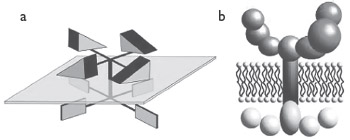
Figure 12.8. Molecular refrigerators that transfer heat to rotational energy will also convert ZPE.
MOVEMENT FROM NOTHING
Empty space can set objects in motion, a physicist claims.33 Motion can be conjured out of thin air, according to a physicist in Israel. Alexander Feigel of the Weizmann Institute of Science in Rehovot says that objects can achieve speeds of several centimeters an hour by getting a push from the empty space of a vacuum.34
His theory and experiment offer a possible explanation for the accelerated expansion of distant galaxies, as well as the motion of fluids.35 Furthermore, Feigel’s discovery opens the way to harness virtual particles to do useful work by creating propulsion.
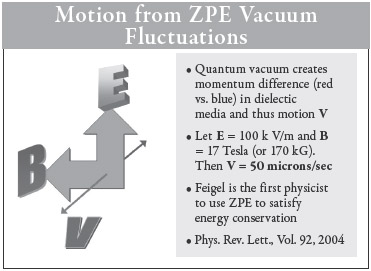
Figure 12.9. My lecture slide explaining the Feigel discovery that ZPE conservation of energy can include a propulsive force in the presence of a static magnetic and electric field
ADDITIONAL ZPE CONVERSION METHODS
Another interesting experiment is the Casimir effect at macroscopic distances, which proposes observing the Casimir force at a distance of a few centimeters using confocal optical resonators within the sensitivity of laboratory instruments.36 This experiment makes the microscopic Casimir effect observable and greatly enhanced. Then, any other modes of conversion for the Casimir force should very well be improved.
In general, many of the experimental journal articles refer to vacuum effects on a cavity that is created with two or more surfaces. Cavity quantum electrodynamics (QED) is a science unto itself. “Small cavities suppress atomic transitions; slightly larger ones, however, can enhance them. When the size of the cavity surrounding an excited atom is increased to the point where it matches the wavelength of the photon that the atom would naturally emit, vacuum-field fluctuations at that wavelength flood the cavity and become stronger than they would be in free space.”37
It is also possible to perform the opposite feat. “Pressing zero-point energy out of a spatial region can be used to temporarily increase the Casimir force.”38 The materials used for the cavity walls are also important. It is well known that the attractive Casimir force is obtained from highly reflective surfaces. However, a repulsive Casimir force may be obtained by considering a cavity built with a dielectric and a magnetic plate. The product r of the two reflection amplitudes is indeed negative in this case, so that the force is repulsive.”39 For parallel plates in general, a “magnetic field inhibits the Casimir effect.”40 Just these tools alone are probably sufficient to build a simple but effective ZPE transducer. For example, if Forward’s corkscrew ZPE battery (figure 12.1) was oscillated periodically within a cavity where the ZPE was pressed out and the Casimir force was increased during one half of the cycle, the spring would tend to attract and force electrons out of the battery by electrostatic repulsion. Then, during the second half of the cycle, electrons would be drawn back into the battery as the spring relaxed, with the Casimir force decreasing. A simple diode rectifier with zero bias voltage in the external circuit will rectify this alternating current (AC) and produce usable electricity. Of course, efficiency calculations and measurements are needed to ensure the overunity production of energy that costs less to produce than the energy generated.
Forward, who passed away in 2002, said:
Before I wrote the paper everyone said that it was impossible to extract energy from the vacuum. After I wrote the paper, everyone had to acknowledge that you could extract energy from the vacuum, but began to quibble about the details. The spiral design won’t work very efficiently. . . . The amount of energy extracted is extremely small. . . . You are really getting the energy from the surface energy of the aluminum, not the vacuum. . . . Even if it worked perfectly, it would be no better per pound than a regular battery. . . . Energy extraction from the vacuum is a conservative process, you have to put as much energy into making the leaves of aluminum as you will ever get out of the battery. . . . Yes, it is very likely that the vacuum field is a conservative one, like gravity. But, no one has proved it yet. In fact, there is an experiment mentioned in my Mass Modification paper (military report on a proposed experiment for an antiproton in a vacuum chamber), which can check on that.
The amount of energy you can get out of my aluminum foil battery is limited to the total surface energy of all the foils. For foils that one can think of making that are thick enough to reflect ultraviolet light so the Casimir attraction effect works, say 20-nm (70 atoms) thick, then the maximum amount of energy you get out per pound of aluminum is considerably less than that of a battery. To get up to chemical energies, you will have to accrete individual atoms using the van der Waals force, which is the Casimir force for single atoms instead of conducting plates. My advice is to accept the fact that the vacuum field is probably conservative and invent the vacuum equivalent of the hydroturbine generator in a dam. 41
To me this was very interesting advice, for someone like me just starting out in vacuum engineering in the 1990s. Forward is probably the first physicist to give considerable thought to the subject of this book, so he deserves some recognition for being a pioneer of ZPE applications. As it turns out, the spiral design is more of a battery than a generator. Also, the mounting evidence for the ZPF is weighing heavily in favor of being a nonconservative field. This means the experts are finding more ways to extract energy from ZPE without putting energy in first.
CASIMIR ENGINE
The Casimir force presents a fascinating exhibition of the power of the ZPF, offering about one atmosphere of pressure when plates are less than one micron apart. As is the case with magnetism today, it has not been immediately obvious, until recently, how a directed Casimir force might be cyclically controlled to do work. The optically controlled vacuum energy transducer of figure 12.4, however, proposed by Pinto presents a powerful theoretical invention for rapidly changing the Casimir force by a quantum surface effect, excited by photons, to complete an engine cycle and thus transfer a few electrons. The convincing part of Pinto’s invention is the quantum mechanics and thermodynamics that he brings to the analysis, offering a conclusive engine for free energy production. Pinto’s company, Interstellar Technologies Corporation (www.Interstellartechcorp.com), is dedicated to “turning quantum vacuum engineering into a commercially viable activity.”42
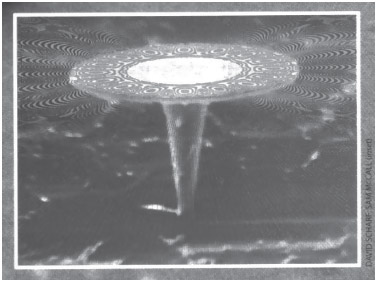
Figure 12.10. Microdisk one micron in diameter
Pinto uses mechanical forces from the Casimir effect and a change of the surface dielectric properties to intimately control the abundance of virtual particles. Basically, it is an optically controlled vacuum energy transducer. A moving cantilever or membrane is proposed to cyclically change the active volume of the chamber as it generates electricity with a thermodynamic engine cycle. The invention proposes to use the Casimir force to power the microcantilever beam produced with standard micromachining technology. The silicon structure may also include a microbridge or micromembrane instead, all of which have a natural oscillation frequency on the order of a free-carrier lifetime in the same material.
The invention is based on the cyclic manipulation of the dimensions of the Casimir cavity created between the cantilever and the substrate. The semiconducting membrane is the cantilever, which could be on the order of 50 to 100 microns in size, with a few-micron thickness in order to obtain a resonant frequency in the range of 10 kHz, for example.
Two monochromatic lasers are turned on, thereby increasing the Casimir force by optically changing the dielectric properties of the cantilever. There is a frequency dependence of a dielectric constant that can vary with frequency by a few orders of magnitude, but inversely proportional to the frequency. This means that as the frequency goes up, the dielectric constant may go down.
Pinto’s proactive approach is to excite a particular frequency mode in the cavity. In doing so, an applied electrostatic charge increases as the cantilever is pulled toward the adjacent substrate by the Casimir force. Bending the charged cantilever on a nanoscale, the Casimir attractive force is theoretically balanced with opposing electrostatic forces, in the same way as Forward’s “parking ramp,” seen in other chapters.
Analysis of the Casimir engine cycle (see ZeroPoint Energy: Fuel of the Future for analysis) demonstrates its departure from hydroelectric, gaseous, or gravitational systems. For example, the Casimir pressure always acts opposite to the gas pressure of classical thermodynamics and the energy transfer that causes dielectric surface changes “does not flow to the virtual photon gas.” Altering physical parameters of the device, therefore, can change the total work done by the Casimir force, in contrast to gravitational or hydroelectric systems. Unique to the quantum world, the type of surface and its variation with optical irradiation is a key to the transducer operation. Normally, changing the reflectivity of a surface will affect the radiation pressure on the surface but not the energy density of the real photons. However, in the Casimir force case, Pinto explains, “The normalized energy density of the radiation field of virtual photons is drastically affected by the dielectric properties of all media involved via the source-free Maxwell equations.”
Specifically, Pinto discovered that the absolute value of the vacuum energy can change “just by causing energy to flow from a location to another inside the volume V.” This finding predicts a major breakthrough in use of a quantum principle to create a transducer of vacuum energy. Some concerns are usually raised, as mentioned previously, with whether the vacuum energy is conserved. In quantum systems, if the parameters (boundary conditions) are held constant, the Casimir force is strictly conservative in the classical sense, according to Pinto. “When they are changed, however, it is possible to identify closed paths along which the total work done by this force does not vanish.”
To conclude the energy production analysis, it is noted by Pinto that 10,000 cycles per second are taken as a performance limit. Taking the lower estimate of 100 erg/cm2 per cycle, power or “wattage” is calculated to be about 1 kW/m2, which is about the same as photovoltaic energy production. However, this invention will work twenty-four hours a day, seven days a week and is not dependent on the sun. The single cantilever transducer is expected to produce about 0.5 nW and establish a millivolt across a kilo-ohm load, which is still fairly robust for such a tiny machine.
The basis of the dielectric formula starts with Pinto’s analysis that the Drude model of electrical conductivity is dependent on the mean electron energy and estimated to be in the range of submillimeter wavelengths. The Drude model, though classical in nature, is often used for comparison purposes in Casimir calculations. The detailed analysis by Pinto shows that carrier concentrations and resistivity contribute to the estimate of the total dielectric permittivity function value, which is frequency dependent. The frequency dependence is of increasing concern for investigations into the Casimir effects on dielectrics. A higher-frequency laser may have significantly different effects than an infrared laser, for example.
Another suggested improvement to the original invention could involve a femtosecond or attosecond pulse from a disk-shaped semiconductor microlaser, such as those developed by Bell Laboratories (figure 12.10). The microlaser could be used in close proximity to the cantilever assembly. Such microlaser structures, called microdisk lasers, measuring 2 microns across and 100 nm thick, have been shown to produce coherent light radially. An optimum choice of laser frequency would be to tune it to the impurity ionization energy of the semiconductor cantilever. In this example, the size would be approximately correct for the micron-sized Casimir cavity, according to the research that I have done investigating this invention.
Pinto chooses to neglect any temperature effects on the dielectric permittivity. However, since then, the effect of finite temperature has been found to be intimately related to the cavity edge choices that can cause the Casimir energy to be positive or negative. Therefore, the contribution of temperature variance and optimization of the operating temperature seems to have become a parameter that should not be ignored. Also supporting this view is the evidence that the dielectric permittivity has been found to also depend on the derivative of the dielectric permittivity with respect to temperature.
The microfabrication task for the Casimir engine includes mounting microlasers inside the Casimir cavity and ensuring that an extended or continuous 10-KHz repetition rate is possible with a moving cantilever by addressing the expected lifespan. It is worth mentioning in support of Pinto that similar cantilevers, made from silicon of the same micron size, with only one support end, now operate in many new automobiles as acceleration and crash sensors, without high failure rates. The energy production rate for the Casimir engine is predicted to be fairly robust (0.5 nW per cell or 1 kW/m2), which could motivate a dedicated research and development project in the future. However, the Casimir engine project of Pinto’s appears to be a million-dollar investment at best, which is to be expected for something so revolutionary. Pinto’s business plan probably addresses the full-scale production costs and projected payback.
Using some of the latest cavity QED techniques, such as mirrors, resonant frequencies of the cavity vs. the gas molecules, quantum coherence, vibrating cavity photon emission, rapid change of refractive index, spatial squeezing, cantilever deflection enhancement by stress, and optimized Casimir cavity geometry design, the Pinto invention may be improved substantially. The process of laser irradiation of the cavity, for example, could easily be replaced with one of the above-mentioned quantum techniques for achieving the same variable dielectric and Casimir force effect, with less hardware involved. At the present stage of theoretical development, the Pinto device receives a moderate rating of feasibility. Its overall energy quality rating, in my opinion, is very high.
WHAT LIES BENEATH THE VOID—NANOCASE PROJECT
A cursory summary of some of the physics behind the ZPE effects is now presented for the nontechnical audience. A more detailed, rigorous review is to be found in my feasibility study called Practical Conversion of Zero-Point Energy (available from Amazon). Let’s begin with a look at a British development called NANOCASE that supports ZPE research on a very significant budget scale. It simply looks for better measurements of the Casimir force (see next section, “Casimir Force”), which is a start in the right direction. Professor Chris Binns (physics and astronomy) at the University of Leicester received European funding in 2005 for an exciting project to measure the force of zero point energy.
The e-bulletin story from the United Kingdom on NANOCASE and Binn has the subtitle “Exciting Project Connected to the ‘Zero- Point Energy’ of Space.” While NANOCASE is the largest ZPE grant so far, the details of the Casimir force, including its positive-to-negative force reversal, have already been worked out by Dr. Jordan Maclay with a NASA grant years ago (discussed in detail in the book Zero Point Energy: The Fuel of the Future). It is true that the replication and verification of previously theorized results will advance this science, even if only by a snail’s pace.
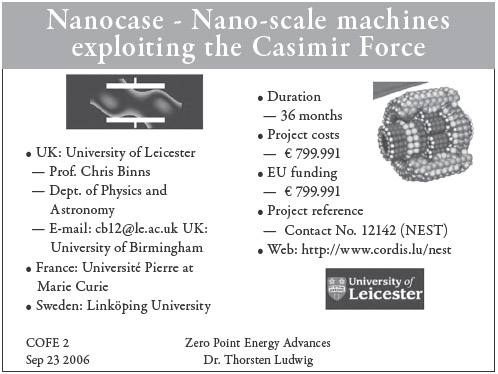
Figure 12.11. Lecture slide explaining the million-dollar grant for zero point energy research
CASIMIR FORCE
It is only appropriate and fitting that the actual simple-but-elegant equation for the Casimir force is also included (figure 12.12). It depends on three constants (Planck’s constant, pi, and the speed of light, where h = h/2) and, of course, the distance L between the plates. There are very few relationships in nature that depend on the fourth power, but here we see one. This causes all of the problems of stiction, with such a dramatic increase in the force as the separation distance L gets really tiny. However, the gecko is happy since this effect lets him stick to any surface (even the Science Channel recently showed a live gecko in a lab and a close-up of the tiny hairs on its feet, which they related to van der Waals forces).
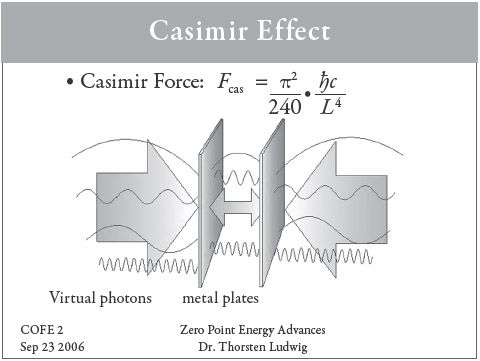
Figure 12.12. The Casimir force equation producing attraction
ZERO POINT ENERGY BASICS
Max Planck, a Nobel Prize winner, corrected his mistake by introducing a second radiation law that made all the difference in the world. Seen in all of its glory in figure 12.13, the important point for nonspecialists is the circled quantity ½ hf. This is the mysterious average of zero point energy when looked at with quantum mechanics. I say “mysterious” because it is exactly half of what physicists normally call a quantum. For example, Planck’s quantum frequency equation, E = hf, gives a clear indication of the quantum units of hf that are present in an atom (with any multiples also allowed by the same equation). However, this is nature that determined the average, and it is also proven or derived from the Heisenberg uncertainty principle.
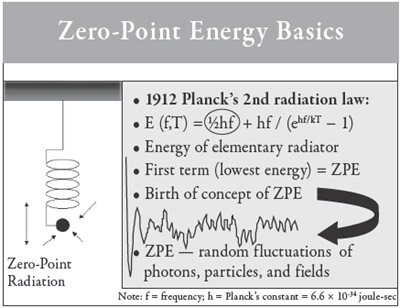
Figure 12.13. Max Planck’s second radiation law that ushered in the modern age of zero point energy, exactly matching the “ black body radiation curve”
ORDER OUT OF CHAOS
Mankind has spent a century nurturing the dead remains of dinosaur fossils for fuel and also reaping the archetypal baggage associated with such morbid necrophilia. Now that we are realizing our actions will seriously impact the planetary inhabitants for another century to come, it is time to look to a more vital energy source. As an alternative, it can be argued that ZPE is a living energy in the broad sense of the word. The ZPF breathes life into every atom, sustaining its size and shape, and it certainly is renewable. Further insights can be gained from the chaotic activity that is at the core of the ZPF. Studying chaos theory, one learns about “strange attractors,” “islands of stability,” and “order out of chaos.” In fact, the Nobel Prize winner Ilya Prigogine wrote a book with the title Order Out of Chaos, which is an excellent discourse on the topic of this section.43 When faced with nonlinear chaotic systems like the ZPF, Prigogine makes the case that such systems will often find stability “far from equilibrium.” With such a counter-intuitive notion, supported by many specific examples in nature, Prigogine explains the title of his book by saying,
“At all levels, be it the level of macroscopic physics, the level of fluctuations, or the microscopic level, nonequilibrium is the source of order. Nonequilibrium brings ‘order out of chaos.’”44
He also delves into an excellent discussion of entropy and the second law of thermodynamics. Prigogine also explains irreversibility with a rediscovery of the fluctuation-dissipation theorem, without apparently knowing about H. B. Callen’s earlier publication. “Intrinsic irreversibility is the strongest property: it implies randomness and instability.”45 Thus we have another fundamental description of ZPE from chaos theory, which also includes a description of the amplification of fluctuations as well.46 Extracting energy from ZPE has just become easier, in so many ways, so that our future will be much brighter and offer much more freedom for everyone.
CONCLUSIONS
Recently, a single nanowire of silicon 300 nm wide has been proven by Charles Lieber from Harvard University to absorb light and create electricity. In response, Phaedon Avouris, a fellow at IBM Research, said, “There has been a lot of talk recently about making independent nanomachines and nanosystems. The issue has always been, how are you going to power them? If you want to have an independent nanosystem that’s self-contained, that’s not plugged into a central power supply, then you need something like this.”47 The same can be said for zero point energy converters, which surprisingly work best and with the most power density, as Dr. Frank Mead pointed out, when made very small.
GLOSSARY
Following are terms that are used throughout the article:
Casimir force: A force attributed to zero point energy fluctuations that is usually attractive and measured between two parallel plates or any two parallel surfaces that come closer than 1 micron apart (1 millionth of a meter). It is the force that keeps a gecko attached to a wall and most insects as well.
Diodes: The solid-state device that is able to send electrical current in one direction only (DC), even if the input is AC electricity, accomplishing “rectification” of the input.
Energy: The capacity for doing work. Equal to power exerted over time (e.g., kilo-watt-hours). It can exist in linear or rotational form and is quantized in the ultimate part. It may be conserved or not conserved, depending on the system considered. Mostly, all terrestrial manifestations can be traced to solar origin, except for zero point energy.
Lamb shift: A shift (increase) in the energy levels of an atom, regarded as a Stark effect due to the presence of the zero point field. Its explanation marked the beginning of modern quantum electrodynamics.
Nanoscale: A small scale of measurement related to nanotechnology (10-9 meters) that is a thousand times smaller than a micron and a source of great innovation today in machines and materials (e.g., carbon nanotubes).
Planck’s constant: The fundamental basis of quantum mechanics that provides the measure of a quantum (h = 6.6 × 10-34 joule-seconds); it is also the ratio of the energy to the frequency of a photon.
Quantum electrodynamics: The quantum theory of light as electromagnetic radiation, in wave and particle form, as it interacts with matter. Abbreviated “QED.”
Quantum vacuum: A characterization of empty space by which physical particles are unmanifested or stored in negative energy states. Also called the physical vacuum.
Uncertainty principle: The rule or law that limits the precision of a pair of physical measurements in complementary fashion (e.g., the position and momentum, or the energy and time), forming the basis for zero point energy.
Virtual particles: Physically real particles emerging from the quantum vacuum for a short time, determined by the uncertainty principle. This can be a photon or other particle in an intermediate state that, in quantum mechanics (Heisenberg notation), appears in matrix elements connecting initial and final states. Energy is not conserved in the transition to or from the intermediate state. Also known as a virtual quantum.
Zero point energy: The nonthermal, ubiquitous kinetic energy (averaging 1/2 hf) that is manifested even at zero degrees Kelvin, abbreviated as “ZPE.” Also called vacuum fluctuations, zero point vibration, residual energy, quantum oscillations, the vacuum electromagnetic field, virtual particle flux, and, recently, dark energy.
Zitterbewegung: An oscillatory motion of an electron, exhibited mainly when it penetrates a voltage potential, with frequency greater than 1,021 Hz. It can be associated with pair production (electron-positron) when the energy of the potential exceeds 2 mc2 (m = electron mass). Also generalized to represent the rapid oscillations associated with zero point energy.